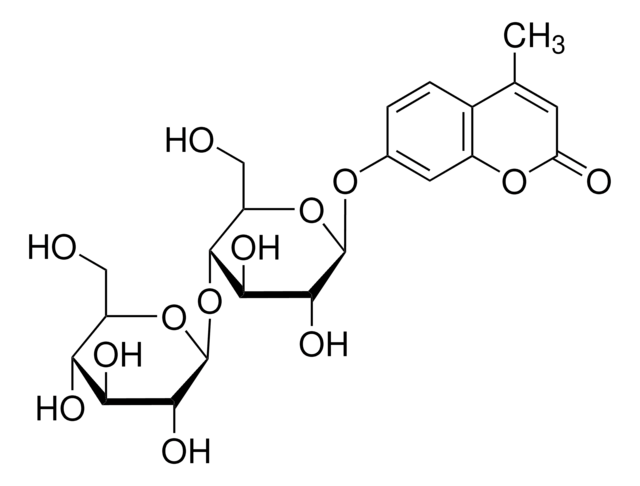추천 제품
생물학적 소스
mouse
Quality Level
결합
unconjugated
항체 형태
purified immunoglobulin
항체 생산 유형
primary antibodies
클론
C5, monoclonal
형태
buffered aqueous solution
분자량
antigen 52-56 kDa
종 반응성
mouse, rat, human
농도
0.5-1.0 mg/mL
기술
immunohistochemistry (formalin-fixed, paraffin-embedded sections): suitable
immunoprecipitation (IP): suitable using 2 μg/mg protein lysate
western blot: 1:500 using 10 μg of Mouse brain lysates
동형
IgG1
UniProt 수납 번호
배송 상태
wet ice
저장 온도
−20°C
타겟 번역 후 변형
unmodified
유전자 정보
human ... MITF(4286)
mouse ... Mitf(17342)
rat ... Mitf(25094)
일반 설명
Microphthalmia (Mi in mouse or MITF in human) is a basic helix-loop-helix-leucine zipper (BHLH–ZIP) transcription factor involved in the differentiation, development and survival of melanocytes and cells of the retinal pigment epithelium, i.e. cells responsible for hair, skin, and eye color. It activates the expression of the melanocyte specific genes tyrosinase and TRP1 (tyrosinase-related protein 1) by binding as a homo- or heterodimer to a symmetrical DNA sequence (E box) (5′-CATGTG-3′) located within the M box found in their promoters. Microphthalmia also appears to be involved in the differentiation of mast cells, osteoclasts, basophils and natural killer cells.
Microphthalmia is expressed in a limited number of cell types including heart, mast cells, osteoclast precursors, and melanocytes. There are a number of different isoforms of microphthalmia resulting from alternative splicing and alternative promotors. These isoforms differ at their amino-termini and in their expression patterns.
Microphthalmia is expressed in a limited number of cell types including heart, mast cells, osteoclast precursors, and melanocytes. There are a number of different isoforms of microphthalmia resulting from alternative splicing and alternative promotors. These isoforms differ at their amino-termini and in their expression patterns.
Mouse monoclonal clone C5 anti-Microphthalmia antibody recognizes serine phosphorylated and non-phosphorylated melanocytic isoforms of microphthalmia from human, mouse or rat.
면역원
N-terminal fragment of human microphthalmia protein.
애플리케이션
Applications in which this antibody has been used successfully, and the associated peer-reviewed papers, are given below.
Western Blotting (1 paper)
Western Blotting (1 paper)
Mouse monoclonal clone C5 anti-Microphthalmia antibody is used to tag serine phosphorylated and non-phosphorylated melanocytic isoforms of microphthalmia for detection and quantitation by techniques such as immunoblotting (doublet of 52-56 kDa), immunoprecipitation, immunohistochemistry on formalin-fixed paraffin embedded or frozen tissue sections, and gel shift. It is used as a probe to determine the roles of microphthalmia in the differentiation, development and survival of melanocytes and cells of the retinal pigment epithelium.
물리적 형태
Solution in phosphate buffered saline containing 0.08% sodium azide.
면책조항
Unless otherwise stated in our catalog or other company documentation accompanying the product(s), our products are intended for research use only and are not to be used for any other purpose, which includes but is not limited to, unauthorized commercial uses, in vitro diagnostic uses, ex vivo or in vivo therapeutic uses or any type of consumption or application to humans or animals.
적합한 제품을 찾을 수 없으신가요?
당사의 제품 선택기 도구.을(를) 시도해 보세요.
Storage Class Code
12 - Non Combustible Liquids
WGK
nwg
Flash Point (°F)
Not applicable
Flash Point (°C)
Not applicable
시험 성적서(COA)
제품의 로트/배치 번호를 입력하여 시험 성적서(COA)을 검색하십시오. 로트 및 배치 번호는 제품 라벨에 있는 ‘로트’ 또는 ‘배치’라는 용어 뒤에서 찾을 수 있습니다.
Miguel F Segura et al.
Proceedings of the National Academy of Sciences of the United States of America, 106(6), 1814-1819 (2009-02-04)
The highly aggressive character of melanoma makes it an excellent model for probing the mechanisms underlying metastasis, which remains one of the most difficult challenges in treating cancer. We find that miR-182, member of a miRNA cluster in a chromosomal
Natalia Pieper et al.
Oncoimmunology, 7(8), e1450127-e1450127 (2018-09-18)
The profound but frequently transient clinical responses to BRAFV600 inhibitor (BRAFi) treatment in melanoma emphasize the need for combinatorial therapies. Multiple clinical trials combining BRAFi and immunotherapy are under way to further enhance therapeutic responses. However, to which extent BRAFV600
Xueping Wang et al.
PloS one, 10(11), e0143142-e0143142 (2015-11-19)
TYR, DCT and MITF are three important genes involved in maintaining the mature phenotype and producing melanin; they therefore participate in neural crest cell development into melanocytes. Previous studies have revealed that the Wnt signaling factor lymphoid enhancer-binding factor (LEF-1)
Li-Ping Liu et al.
Cell reports, 27(2), 455-466 (2019-04-11)
Induced pluripotent stem cells (iPSCs) are a promising melanocyte source as they propagate indefinitely and can be established from patients. However, the in vivo functions of human iPSC-derived melanocytes (hiMels) remain unknown. Here, we generated hiMels from vitiligo patients using a three-dimensional
자사의 과학자팀은 생명 과학, 재료 과학, 화학 합성, 크로마토그래피, 분석 및 기타 많은 영역을 포함한 모든 과학 분야에 경험이 있습니다..
고객지원팀으로 연락바랍니다.